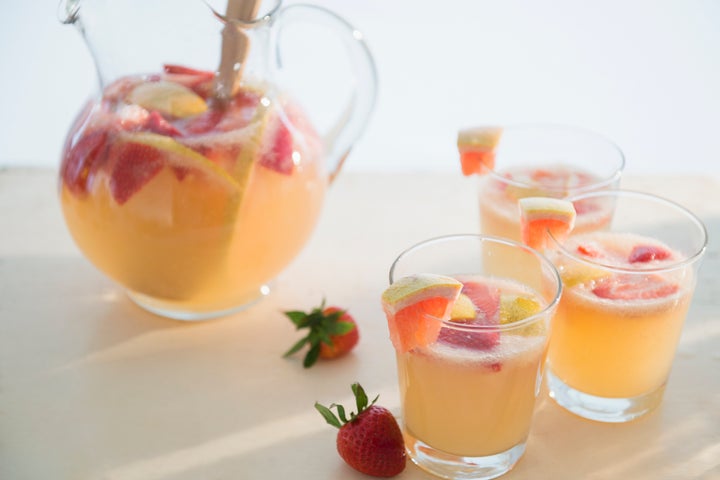
Sangria – a delicious concoction of wine, fruit and liquor – has roots in Spain and Portugal, and maybe the West Indies.
It’s become a ubiquitous warm-weather beverage due to its refreshing and drinkable qualities, and the availability to snack on booze-soaked fruit.
Sangria is versatile (it can be made with red, white or even rosé), pairing well with different kinds of wines and fruits. But making it based on some expert-recommended guidelines can make it a whole lot better.
HuffPost asked wine experts to give tips on how to make the best sangria at home, and they delivered.
Make a fruit-forward version
“I love sangria because I’m a fruity person. I like fruit,” said Marcia McColl, who teaches classes at The Capital Wine School in Washington D.C. “You get to soak the fruit in brandy, which is good. I like red wine more, so I do red wine mostly.”
For reds, McColl suggested a semi-dry wine, like House of Brown red blend or Lini 910 Lambrusco, a sparkling red. “I’ve also done pinot noir because it’s on the lighter end,” she said. “It is not as aromatic and too heavy, like a cabernet.”
She also recommended white wine such as Vinho Verde, which Trader Joe’s sells for $5 a bottle. Dark Horse’s roses and pinots are good options, she said. She tends to pick affordable wines from wineries owned by women and people of colour.
If she’s using sparkling wine, the sangria already has bubbles in it. But if she’s using a non-sparkling wine, she’ll add carbonated water.
Many recipes call for sugar and orange juice, but McColl jettisons both. The orange juice isn’t needed, as she pours in an orange-y triple sec like Cointreau. However, she said you can add orange or cranberry juice if you’d like. “It’s best to just kind of soak the fruit in dark liqueur for 24 hours,” she said.
Bourbon, rum, brandy, port and cognac work well, but she won’t add clear liquors like vodka or tequila ― “unless you want to turn into the Hulk,” she said. She thinks tequila adds a “harsh” flavour, and vodka overpowers the sangria. The goal is to balance the tart with the sweet.
“Sangria is like making soup. Once you’ve done a little bit, you realize, ‘I could substitute this for this,’ and the intimidation factor goes down really quick.”
- Jeri Carter
McColl’s favorite fruits to use are mangoes, but she also likes peaches, strawberries and in-season pineapple. She cuts the fruit but does not muddle it, and mixes it with the wine after marinating it.
“Once you get to the bottom of the glass, it’s another special treat,” she said about the fruit.
To make sangria, pour an entire bottle of wine into a pitcher and add half a cup of liquor or liquors/liqueurs along with a half- or third-cup of fruit.
For garnish, McColl suggested placing mint, strawberry or an orange slice on the side of a wine glass.
Try using mead and... Sprite?
Jeri Carter, the owner of Tupelo, Mississippi’s Queen’s Reward Meadery, has been experimenting with mead and sangria. Mead is a rather esoteric wine that not a lot of people know about. Basically, it’s fermented honey mixed with water and fruits, so it’s already fashioned for sangria.

“To me, the appeal of sangria is that some people don’t really like the taste of wine,” Carter said. “They like the idea of it. They don’t love the taste of it, which I think is one reason why our blackberry and our cranberry and our lemon meads are appealing to people. They don’t have that wine flavour. And I think sangria is a way to take a fairly accessible ingredient and make it something that more people like.”
Like McColl, Carter agreed a semi-dry or semi-sweet red work well. But if someone wants a sweeter sangria, they can add a Moscato or a dash of Sprite.
“I think if you hit it with a dry champagne or some sort of a sparkling wine that doesn’t add sweetness like Sprite would, I think it’d be just right,” she said.
Carter likes to add strawberries, blueberries and apple chunks, but said adding an orange slice makes the sangria too bitter, so it’s best to leave it as a garnish. She opts to soak the fruit in the wine, not the liquor.
Fresh fruit, including fruit that’s about to go bad, should be used instead of frozen options. However, it can be fun to experiment with freezing the fruit in wine and making ice cubes or a slushie. Carter said frozen peaches might work better than fresh ones because placing peaches in the wine would make the peaches mushy.
“Sangria is like making soup,” she said. “Once you’ve done a little bit, you realise, ‘I could substitute this for this,’ and the intimidation factor goes down really quick.”
Unlike McColl, Carter likes a shot of tequila in the sangria. “I wouldn’t think the tequila in there would’ve been good,” she said of experimenting with the liquor in sangria. “And I’m thinking, well, let me try this and I’ll be optimistic. It was delicious. I was really surprised.”
Next, she’s thinking about making a spicy sangria using her honey habanero mead. “The spice is not too much,” she said. “As you add those other fruits and other juices and things, it’s going to kind of dilute that spiciness just a little bit.”
Despite what you do or don’t put in sangria, people can agree sangria is perfect for summertime. “You’re still getting that little bit of alcohol, but not too much,” Carter said. “One glass is not going to completely knock you out. Wine is delicious, but it’s usually not refreshing. But when you add fruit juice to it, it’s perfect for sitting outside and sipping on a hot summer day.”